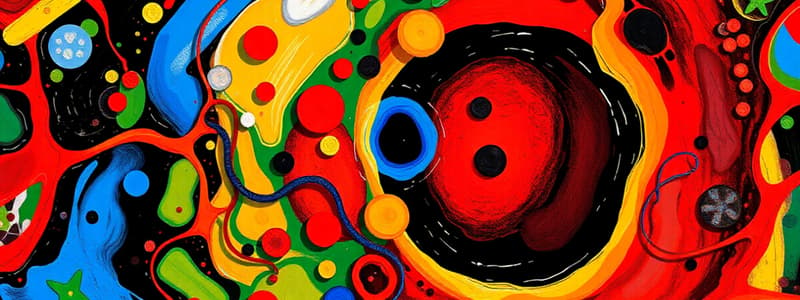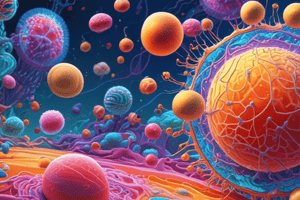Podcast
Questions and Answers
What is the primary function of the mitochondria?
What is the primary function of the mitochondria?
- Detoxification of substances
- Protein synthesis
- Energy production (correct)
- Genetic material storage
Which component of the cell is responsible for regulating cell activities through gene expression?
Which component of the cell is responsible for regulating cell activities through gene expression?
- Mitochondria
- Endoplasmic reticulum
- Golgi apparatus
- Nucleus (correct)
Which type of endoplasmic reticulum is involved in protein synthesis?
Which type of endoplasmic reticulum is involved in protein synthesis?
- Nucleus
- Smooth ER
- Rough ER (correct)
- Golgi apparatus
What structure is essential for the transport and packaging of proteins and lipids?
What structure is essential for the transport and packaging of proteins and lipids?
What is the main role of lysosomes?
What is the main role of lysosomes?
What component of the cell membrane contributes to its selectively permeable nature?
What component of the cell membrane contributes to its selectively permeable nature?
How does the structure of the cell membrane contribute to its function?
How does the structure of the cell membrane contribute to its function?
What is the role of the nucleolus within the nucleus?
What is the role of the nucleolus within the nucleus?
What is the primary function of ribosomes in a cell?
What is the primary function of ribosomes in a cell?
Which component of the cell is primarily involved in cellular movement and structure?
Which component of the cell is primarily involved in cellular movement and structure?
What significant role does the vacuole serve in human cells?
What significant role does the vacuole serve in human cells?
During which stage of mitosis do chromosomes align in the center of the cell?
During which stage of mitosis do chromosomes align in the center of the cell?
Which cellular process is primarily regulated by signaling molecules and receptors?
Which cellular process is primarily regulated by signaling molecules and receptors?
What structure protects and transports materials within a eukaryotic cell?
What structure protects and transports materials within a eukaryotic cell?
What occurs during telophase in mitosis?
What occurs during telophase in mitosis?
What is the role of the cytoplasm in the cell?
What is the role of the cytoplasm in the cell?
Flashcards
Ribosomes
Ribosomes
Small, non-membrane-bound organelles made of RNA and proteins. Found on rough endoplasmic reticulum or free in the cytoplasm.
Cytoplasm
Cytoplasm
The jelly-like substance within a cell where organelles are suspended. It allows the movement of materials within the cell
Cytoskeleton
Cytoskeleton
A network of protein filaments and tubules that provide structure and aid in movement. It helps maintain cell shape and allows for movement of organelles.
Vacuoles
Vacuoles
Signup and view all the flashcards
Vesicles
Vesicles
Signup and view all the flashcards
Prophase
Prophase
Signup and view all the flashcards
Metaphase
Metaphase
Signup and view all the flashcards
Mitosis
Mitosis
Signup and view all the flashcards
What is a human cell?
What is a human cell?
Signup and view all the flashcards
What are the two main types of human cells?
What are the two main types of human cells?
Signup and view all the flashcards
What is the cell membrane?
What is the cell membrane?
Signup and view all the flashcards
What is the nucleus?
What is the nucleus?
Signup and view all the flashcards
What are mitochondria?
What are mitochondria?
Signup and view all the flashcards
What is the endoplasmic reticulum (ER)?
What is the endoplasmic reticulum (ER)?
Signup and view all the flashcards
What is the Golgi apparatus?
What is the Golgi apparatus?
Signup and view all the flashcards
What are lysosomes?
What are lysosomes?
Signup and view all the flashcards
Study Notes
Human Cell Structure and Function
- A human cell is the fundamental unit of life
- Cells are of two types: somatic cells and germ cells
- Somatic cells perform various functions such as energy production, growth, reproduction, and communication.
Cell Components
- Cells comprise various organelles, each with specific roles
- Key organelles include the nucleus, mitochondria, cell membrane, endoplasmic reticulum, Golgi apparatus, and lysosomes
Cell Membrane
- Structure: Phospholipid bilayer with embedded proteins, cholesterol, and carbohydrates.
- Function: Selectively permeable barrier; facilitates communication via receptors and channels; protects cellular integrity
Nucleus
- Structure: Nuclear envelope, nucleoplasm, nucleolus, and chromatin.
- Function: Control center, houses genetic material (DNA); regulates cell activities through gene expression.
- Nucleolus: Responsible for ribosome production
Mitochondria
- Structure: Double membrane with inner folds (cristae) increasing surface area
- Function: Energy production (ATP) through cellular respiration
- Role in apoptosis (programmed cell death)
- Contains their own DNA, supporting endosymbiotic theory
Endoplasmic Reticulum (ER)
- Structure: Network of membrane-bound tubes and sacs
- Types:
- Rough ER: Studded with ribosomes, involved in protein synthesis
- Smooth ER: Lacks ribosomes, involved in lipid synthesis and detoxification
- Function: Transports and synthesizes molecules
Golgi Apparatus
- Structure: Stacks of flattened membrane-bound sacs (cisternae)
- Function: Modifies, sorts, and packages proteins and lipids for transport to destinations; produces lysosomes; works closely with the ER
Lysosome
- Structure: Membrane-bound vesicles containing hydrolytic enzymes
- Function: Breaks down waste, damaged cell parts, and pathogens; involved in apoptosis (programmed cell death)
- Role in maintaining cellular health by removing debris
Ribosomes
- Structure: Small, non-membrane-bound organelles made of RNA and proteins
- Location: Found on rough ER or free in the cytoplasm
- Function: Sites of protein synthesis (translation of mRNA into polypeptides)
- Role in gene expression and cellular function
Cytoplasm and Cytoskeleton
- Cytoplasm: Gel-like fluid where organelles are suspended; allows movement of materials within the cell.
- Cytoskeleton: Network of protein filaments and tubules (microtubules, actin filaments, intermediate filaments) that provide structure and aid in movement
Vacuoles and Vesicles
- Vacuoles: Larger in plant cells, but present in human cells for storage of substances
- Vesicles: Small membrane-bound sacs transporting materials within or in and out of the cell.
- Function: Storage and transport of nutrients, waste, and other materials.
Cell Division (Mitosis)
- Overview of mitosis stages:
- Prophase: Chromosomes condense; nuclear membrane dissolves
- Metaphase: Chromosomes align in the center
- Anaphase: Sister chromatids separate
- Telophase: Nuclear membrane reforms; cell begins to divide
- Role of mitosis: Growth, repair, and reproduction of somatic cells
Cellular Functions and Communication
- Cells communicate through signaling molecules and receptors (e.g., hormones, neurotransmitters).
- Cell signaling regulates processes such as growth, immune response, and homeostasis.
- Communication through gap junctions, tight junctions, or chemical signals.
Conclusion
- Each part of the cell has a specific function maintaining the organism's viability.
- Somatic cells reproduce through mitosis; germ cells through meiosis.
- Understanding cellular processes is crucial to comprehend human physiology and pathophysiology.
Studying That Suits You
Use AI to generate personalized quizzes and flashcards to suit your learning preferences.
Related Documents
Description
Test your knowledge on the fundamental unit of life - the human cell. This quiz covers various aspects including cell types, organelles, and their specific functions. Understand the complexities of cellular structures and how they contribute to life.




